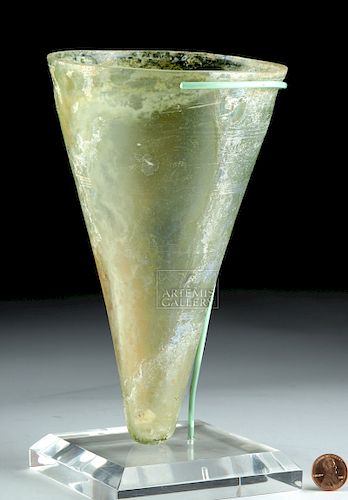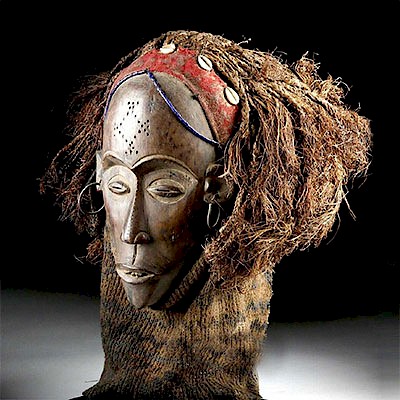Published Roman / Byzantine Glass Oil Lamp
Lot 34
About Seller
Artemis Gallery
686 S Taylor Ave, Ste 106
Louisville, CO 80027
United States
Selling antiquities, ancient and ethnographic art online since 1993, Artemis Gallery specializes in Classical Antiquities (Egyptian, Greek, Roman, Near Eastern), Asian, Pre-Columbian, African / Tribal / Oceanographic art. Our extensive inventory includes pottery, stone, metal, wood, glass and textil...Read more
Estimate:
$1,900 - $2,850
Absentee vs Live bid
Two ways to bid:
- Leave a max absentee bid and the platform will bid on your behalf up to your maximum bid during the live auction.
- Bid live during the auction and your bids will be submitted real-time to the auctioneer.
Bid Increments
| Price | Bid Increment |
|---|---|
| $0 | $25 |
| $300 | $50 |
| $1,000 | $100 |
| $2,000 | $250 |
| $5,000 | $500 |
| $10,000 | $1,000 |
| $20,000 | $2,500 |
| $50,000 | $5,000 |
| $100,000 | $10,000 |
| $200,000 | $20,000 |
About Auction
By Artemis Gallery
Apr 4, 2019
Set Reminder
2019-04-04 10:00:00
2019-04-04 10:00:00
America/New_York
Bidsquare
Bidsquare : Ancient / Ethnographic From Around The World
https://www.bidsquare.com/auctions/artemis-gallery/ancient-ethnographic-from-around-the-world-4003
Ancient art from Egypt, Greece, Italy and the Near East, as well as Asian, Pre-Columbian, Native American, African / Tribal / Oceanic, Spanish Colonial, Russian Icons, Fine art, much more! All categories, all price ranges... all legally acquired and guaranteed to be as described or your money back Artemis Gallery info@artemisgallery.com
Ancient art from Egypt, Greece, Italy and the Near East, as well as Asian, Pre-Columbian, Native American, African / Tribal / Oceanic, Spanish Colonial, Russian Icons, Fine art, much more! All categories, all price ranges... all legally acquired and guaranteed to be as described or your money back Artemis Gallery info@artemisgallery.com
- Lot Description
Late Roman Imperial Period to Early Byzantine, ca. 4th century CE. A conical, semi-translucent glass vessel with a rounded bottom and a thick, flat rim, almost colorless with tinges of beautiful sage green hues with liberal areas of purple, rainbow, and silvery iridescence, the exterior wall surfaces adorned by four equidistantly placed bands of fine wheel cut lines around the body. Archaeologists have discovered such forms in ancient tombs. Some historians believe that they were used as lamps for the deceased to carry with them to the next world. A quote from the Roman Christian poet Prudentius (348-413 CE) poetically describes such lamps in actual use (see extended description below) . Beautiful rainbow and purple iridescence with weathering film that is the result of thousands of years of graceful aging. Size: 4.75" in diameter x 7.875" H (12.1 cm x 20 cm); 8.625" H (21.9 cm) on included custom stand.
The following eloquent quote from Prudentius captures the magical quality of a lamp like this example, "As for us, we pass the long night with pious gladness in festal congregations, in sleepless prayer we earnestly heap up petitions that will be granted, and on the altar raised up make offerings to God. The lamps gleam out, that hang by swaying cords from every panel of the roof, and the flame, fed by the oil on which it floats lazily, casts its light through clear glass. One would think the starry space stood over us, decked with the twin Bears, and that bright evening stars were everywhere scattered, where the Wain directs its team of oxen. How worthy a thing, O God, for Thy flock to offer Thee at dewy night's beginning - light, Thy most precious gift, light, by which we perceive all Thy other blessings." (Prudentius, Cathemarina V. 137-152 - from Fortuna Fine Arts, Ltd. Catalogue entitled "Solid Liquid: Greek, Roman, Byzantine and Islamic Glass" (New York: 1999), p. 110. Also see similar examples of conical lamps in this publication - figures 199 and 200, pages 110-111).
This piece was published in the "Solid Liquid" catalogue (Fortuna Fine Arts, 1999) - figure 199, page 110. The description states that this type of vessel was used in the late Roman to early Byzantine periods, and was "designed to be filled with oil and placed into large metal fixtures. These fixtures contained multiple lamps and provided illumination in the same way that a candelabrum does today. A fine example of this class of glass lamps, this piece has a conical shape with a ground rim and groups of finely abraded bands over its entire length. Areas of encrustation and iridescent highlights."
The author also points to the following for similar pieces - Whitehouse, Corning, no. 427, p. 250. Also cf. Essen, no. 118, p. 41; ROM, no. 477, p. 121; Yale, no. 263, p. 98.
Provenance: private East Coast, USA collection; published in "Solid Liquid" catalogue (Fortuna Fine Arts, 1999) - figure 199, page 110.
All items legal to buy/sell under U.S. Statute covering cultural patrimony Code 2600, CHAPTER 14, and are guaranteed to be as described or your money back.
A Certificate of Authenticity will accompany all winning bids.
We ship worldwide and handle all shipping in-house for your convenience.
#135464Expected surface wear with weathering film and stunning rainbow, purple, and silvery iridescence. Generally excellent.Condition
- Shipping Info
-
All shipping is handled in-house for your convenience. Your invoice from Artemis Gallery will include shipping calculation instructions. If in doubt, please inquire BEFORE bidding for estimated shipping costs for individual items.
-
- Buyer's Premium



 EUR
EUR CAD
CAD AUD
AUD GBP
GBP MXN
MXN HKD
HKD CNY
CNY MYR
MYR SEK
SEK SGD
SGD CHF
CHF THB
THB













